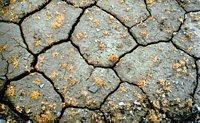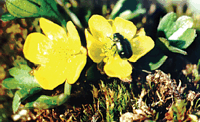
 | Laboratories \ Laboratory for Synecology \ Goals and Tasks |
| Goals and Tasks |  | Publications |  | Scientific Staff |
 |
LABORATORY FOR SYNECOLOGY
MAIN GOALS AND TASKS
Academician Yu.I. Chernov 
This seemingly lifeless soil inhabited for at least 20 species of arthropods 
Earth's most northern leaf beetle – Chrysolina septentrionalis The main problems of scientific research:
The basic principle of the work implies the use of a wide range of model objects for the solution of problems related to the structure, dynamics and functioning of ecological communities and formation of biotic systems. The main criterion for the choice of model objects is their high specific, taxonomic and ecological (adaptive types) diversity, much attention being given to extreme environmental conditions. The main research lines developed in the Laboratory:
The main achievements for the latest 10 years: A system of synecological and biotic mechanisms of compensation, providing overlapping of "ecological space" under drastic lowering of the species richness of the fauna and flora was elaborated. Such mechanisms included Tinemann's rule (increase in population density under depletion of specific composition), broadening of ecological niches and multi-dominance, increase in a relative abundance of particular faunas, floras, and taxocenes, and increase in intraspecific diversity and intraspecific adaptive radiation. The importance of compensatory mechanisms is best displayed in communities and biotas of the Arctic, especially in arctic tundra and polar deserts, as well as in communities of small islands, arid landscapes, ephemeral substrates, and different types of anthropogenic biotopes. The analysis of latitudinal-zonal structure and landscape chorology of the organic world resulted in revealing the distribution patterns for different plant and animal taxa ecologically important and significant for evolutionary theory. Particularly, a phenomenon of zonal vicariate or ecological substitution of taxa of the higher rank was described; the latitudinal gradients of biological diversity were studied in detail from the example of collembolans. A regular decrease in the proportion of the most progressive groups of organisms in the flora and fauna was shown from the tropics to the poles; the concept of the advantages of "tolerant-passive" adaptive strategies (more inherent to relatively primitive forms) under extreme climatic conditions was substantiated. The taxonomic structure of the Arctic biota as a whole (all kingdoms) has been analyzed for the first time. The main feature of the Arctic biota structure was shown to be a lower proportion of the most advanced taxa and the predominance of relatively primitive groups according to their adaptive possibilities and diversity, especially in the most high-latitudinal landscapes. However, the percentage of proper arctic species in the fauna and flora is highest (20-40%) in most advanced taxa. Adaptation by the latter to the arctic environment is associated with the transition to the level of speciation and macroevolutionary changes, whereas primitive groups inhabit high latitudes due to initial pre-adaptive mechanisms. The idea that the Arctic biota formation results not only from a depletion of the species composition, but it is a consequence of the complicated process of realizing the adaptive potential of large phyletic groups under high-latitudinal conditions has been substantiated. Schemes of typology for the landscape-zonal species distribution in the Arctic, the essence of the notion "arctic species" and its features in different groups of the organic world depending on the phylogenetic level of taxa were considered. The taxonomic compositions and structure of the arctic fauna of leading animal groups (Collembolans, Carabidae, Lepidopterans, and birds) were analyzed in detail. In recent years, much attention was given to communities and biota of polar deserts: unique data on the flora and fauna composition, structure and production of biocenoses, adaptive features and areas of plant and animal species, age of modern polar deserts etc. were obtained. The unique features of polar deserts (specific biocenotic interrelations, species composition, areas and so on) were revealed along with the extremely poor species composition of polar desert communities. The status of polar deserts as a separate nature zone, equivalent to the tundra zone by its rank, was justified. A review on the structure of acarocenoses of polar deserts for both hemispheres considering the reasons for the prosperity of prostigmatic mites in near-polar areas was published. A phenomenon of mass coprophagy in collembolans of polar deserts where their number reached record values was revealed. The taxonomic and arealogic structure of the class Collembola of the arctic fauna has been analyzed for the first time. An annotated list of arctic collembolans was published. Within this ancient group of terrestrial Arthropoda with spacious area, faunogenetic complexes are distinctly distinguished. These complexes correspond to the generally accepted biogeographic division of the Holarctic. According to these data, the Arctic is not more integral in faunogenetic aspect than boreal regions of the Holarctic. The commonness of the Collembola fauna in arctic regions and its structural peculiarities was shown to reflect principally ecological and not historical factors of faunogenesis. The results of long-term studying the consequences of tree damage, forest regeneration and succession dynamics in the loci of phylophagous insect outbreaks, effects of defoliation on physiological processes in trees, microclimate and cenotic relations in forest communities were summarized. "Positive" relations between bird species, leading to the formation of their associations in forest communities of the temperate zone have been analyzed, and a review on this problem was published. The intraspecific attraction was shown to affect the population structure of nesting birds contrary to the idea about positive links between stability and diversity. Forest communities with the highest species diversity of birds and plants may differ by the highest level of variation in the total number of birds. The data on the structure of bird populations in Moscow parks were generalized, and their typologization was carried out. It was shown that the increase in the proportion of species nesting in tree hollows in bird populations could serve as an indicator of the intensity of human-induced transformation of urban parks. The data on influence of global warming on ecology of separate species, cenotic relations and organization of multispecific groups of birds in the forest zone were analyzed. An increase in the number and a relative significance of some resident species and partial migrants in communities, especially in urbocenoses was observed, probably, due to multiplicative effects several interacted factors (milder conditions of wintering, the presence of additional food sources, lower species diversity of predators violating the nests of these species etc.). The more intense competition between resident and migratory species in the nesting areas is predicted under the growing density of residents’ nesting. The team of the Lab took part in the compilation and edition of the Red Data Book for the city of Moscow. The criteria of the species-indicators selection among invertebrates for their inclusion into the Red Data Books of megalopolises were developed; the experience of the organization of species diversity conservation for entomokompleks through regional Red books is generalized. |